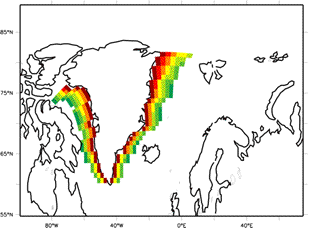CORE III
The proposal to run a freshwater perturbation experiment in the CORE framework continues to be endorsed by WGOMD. The figure below shows the hosing perturbation of 0.1Sv put forward by Gerdes et al (2006) that would represent an increase in melt water input from Greenland. This is in contrast to the unrealistic historical practice of applying a freshwater perturbation uniformly over a North Atlantic box. It is argued that a more realistic distribution of a water flux anomaly relative to the pathways of the North Atlantic meridional overturning circulation is important for the transient response of the ocean. The proposed perturbation is slightly stronger than the average increase in meltwater flux from Greenland estimated over the next 500 years (Huybrechts and Wolde, 1999) and it is kept constant during the 100 year experiment, which is unlikely to be the case in reality.
The experiment would be spun up with CORE-I normal year forcing, with the last 100 years repeated with the freshwater perturbation. Continuing the simulation for a recovery period would be optional. The choice of surface boundary condition remains open and could be coupled or partially-coupled, for example by an anomaly-EBM.
Figure: Distribution of surface freshwater flux anomaly (from Gerdes et al 2006).

How realistic is the CORE III freshwater perturbation?
The set-up of CORE III is very simplified and by no means reflects all the aspects of likely changes in fresh water fluxes in the northern North Atlantic. Some things in CORE III were chosen to be similar to the CMIP water hosing experiment. The magnitude of the fresh water flux perturbation (0.1 Sv) is the same as in CMIP. This number is somewhat realistic when we consider the changes in all fresh water sources to the Atlantic high northern latitudes under increasing greenhouse gas concentrations. Based on IPCC scenario calculations, the catchment area of the rivers draining into the Arctic and the Arctic itself will receive 1000 to 2000 km3/yr more fresh water at the end of the current century compared to its beginning (R.Gerdes, pers.comm.). There might also be some more melt water from Greenland and from melting permafrost; the amount is very uncertain today. The IPCC AR4 gives a range of 0.4 to 0.28 mm/yr of sea level rise due to melting of the Greenland ice sheet in the A2 scenario. A rise of 3 mm/yr corresponds to a fresh water flux of around 1000 km3/yr. Changes in hydrological cycle and in ablation from Greenland could thus mean that up to 3000 km3/yr of additional fresh water could enter the Arctic, the Nordic Seas, the Irminger Sea, Baffin Bay and the Labrador Sea.
It is unrealistic to presume that the fresh water input will increase instantaneously by 3000km3/yr (which is about 0.1 Sv). But the switch-on character of the forcing is consistent with CMIP. The future development of the fresh water fluxes is uncertain and modified experiments with more realistic temporal behavior should perhaps start after experience with a simple set-up has been gained.
It would be most realistic for most of the additional fresh water to be inserted at the mouth of the major rivers in the Arctic and along the Arctic continental margins. However, to also reflect the increasing ablation from Greenland and to keep the design simple we chose to insert the fresh water along eastern and western Greenland. This is justified because the additional fresh water supplied to the Arctic will be advected along its usual pathways from the Siberian shelves to the Canadian Archipelago and Fram Strait. Thus, this fresh water will end up in the East Greenland Current and in Baffin Bay. This geographical setting is significantly more realistic than the CMIP approach of water hosing of the whole North Atlantic between 50N and 70N. The pathways of the fresh water are pretty well known as are the locations of possible sources of additional fresh water and these are to some degree reflected in the CORE III design. It is significant because putting the fresh water into the boundary currents around Greenland implies a shorter, more realistic residence time of the fresh waters in Baffin Bay and especially in the Nordic Seas, a deviation from the CMIP design which could impact stratification and circulation in the northern North Atlantic.
References
Gerdes, R., S. M. Griffies, and W. Hurlin, 2005: Reaction of the oceanic circulation to increased melt water flux from Greenland - a test case for ocean general circulation models. CLIVAR Exchanges, 10, 28-31.
Huybrechts, P., and J. de Wolde, 1999: The dynamic response of the Greenland and Antarctic ice sheets to multiple century climate warming, J. Climate, 1, 2169-2188.













